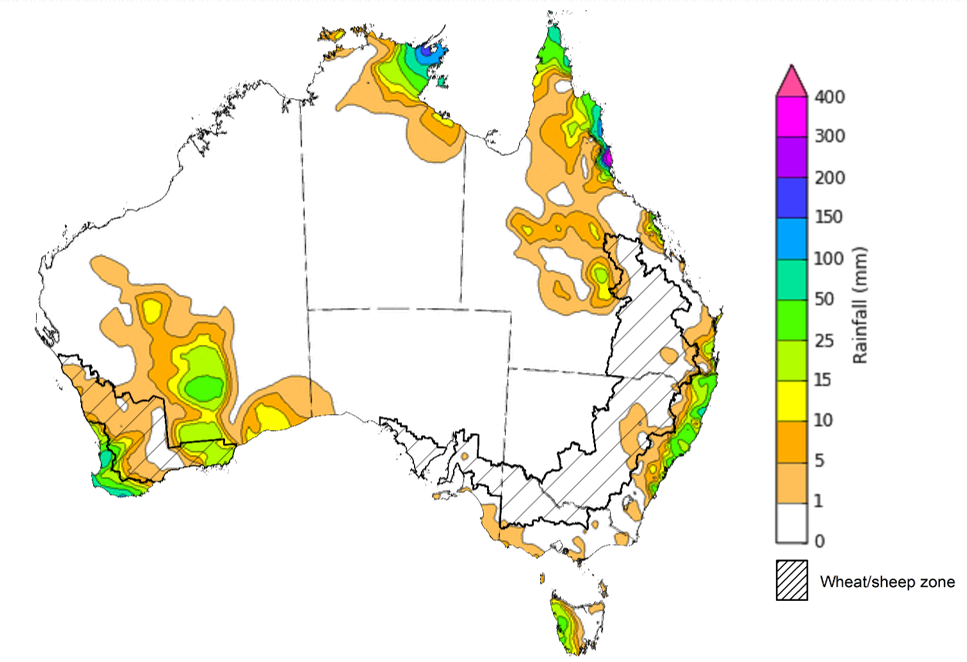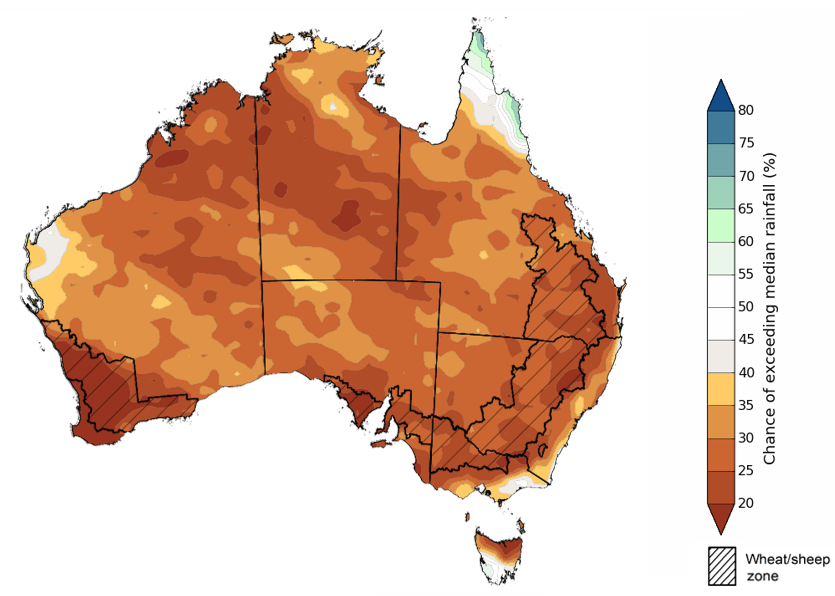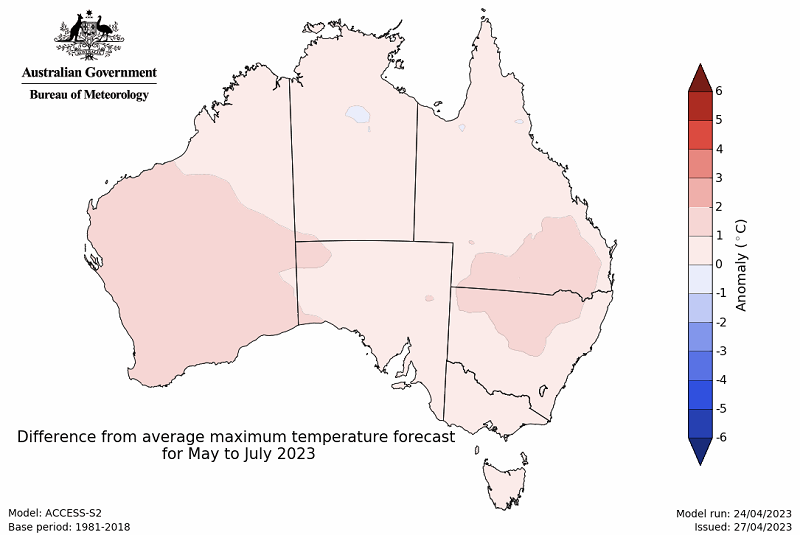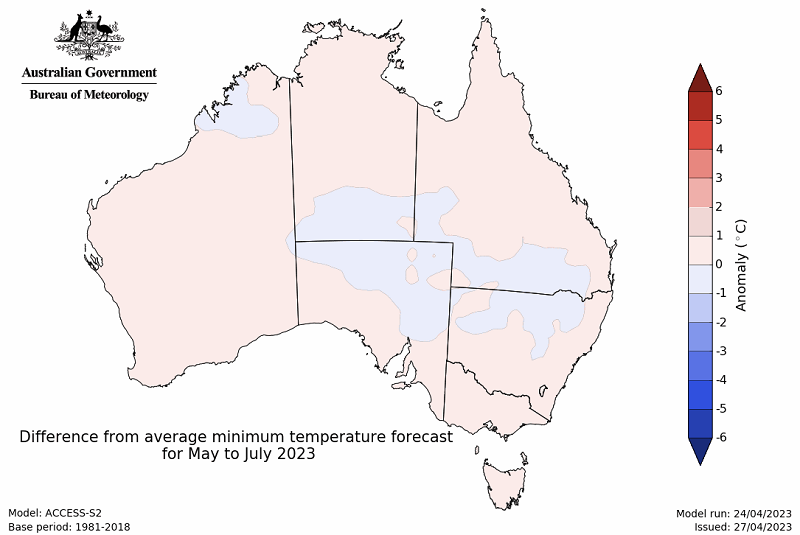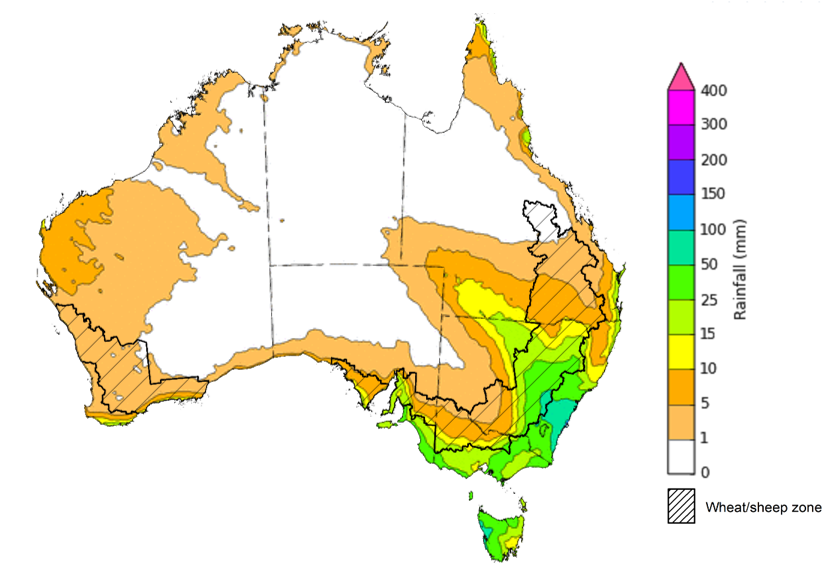Key issues
- For the week ending 26 April 2023, high pressure systems brought little to no rainfall to much of Australia. Meanwhile, a low-pressure trough across northern Queensland combined with south-easterly airflow resulted in heavy falls in parts of the North Tropical Coast and Gulf Country. Onshore airflow brought locally heavy showers to coastal parts of northern New South Wales and northern Queensland coasts. A cold front resulted in heavy rainfall across southern parts of Western Australia.
- In cropping regions, rainfall total of up to 25 millimetres was recorded across south-eastern Western Australia. Little to no rainfall was recorded across the remaining cropping regions. Harvesting of summer crops would have continued with the clear, dry conditions (see Section 1.1).
- The El Niño–Southern Oscillation is in its neutral phase. The El Niño WATCH issued by the Bureau of Meteorology continues. The Indian Ocean Dipole (IOD) is currently neutral. A positive IOD event may develop in the coming months. A positive IOD can suppress winter and spring rainfall over much of Australia, potentially exacerbating the drying effect of El Niño, should it occur (see Section 1.2).
- The outlook for May 2023 indicates drier than average conditions are expected across much of Australia. Given that many winter cropping regions have received enough rainfall to classify as an early autumn break, these forecast rainfall totals are likely to be sufficient to provide a favourable start to the winter season (see Section 1.3).
- The outlook for May to July 2023 suggests there is a 75% chance of rainfall totals over 25 millimetres across central and eastern New South Wales, the southeast and northeast of Queensland, southern parts of South Australia and Western Australia, and across Victoria and Tasmania. Across most winter cropping regions there is a 75% chance of receiving between 25 and 100 millimetres, except for central and northern Queensland where rainfall totals are expected to be below 25 millimetres (see Section 1.3).
- Over the 8-days to 4 May 2023, troughs and a front are expected to trigger showers over southern parts of Western Australia and South Australia. A front and a low will generate showers and storms over Victoria, New South Wales, Tasmania and southern Queensland. Onshore, moist winds will trigger showers over southeast Queensland and northeast New South Wales. The high-pressure systems will keep the interior clear and dry (see Section 1.4).
- Across Australian cropping regions, rainfall totals of up to 50 millimetres are expected for central and northern New South Wales and up to 25 millimetres in southern Victoria and South Australia. Little to no rainfall is expected for the remaining cropping regions (see Section 1.4).
- Water storage levels in the Murray-Darling Basin (MDB) decreased between 20 April 2023 and 27 April 2023 by 353 gigalitres (GL). Current volume of water held in storage is 19 603 GL. This is 1 percent or 224 GL more than at the same time last year.
- Allocation prices in the Victorian Murray below the Barmah Choke decreased from $11 on 20 April 2023 to $10 on 27 April 2023. Prices are lower in the Murrumbidgee and regions above the Barmah choke due to the binding of the Murrumbidgee export limit.
Climate
For the week ending 26 April 2023, high pressure systems brought little to no rainfall to much of Australia. Meanwhile, a low-pressure trough across northern Queensland combined with south-easterly airflow resulted in heavy falls in parts of the North Tropical Coast and Gulf Country. Onshore airflow brought locally heavy showers to coastal parts of northern New South Wales and northern Queensland coasts. A cold front resulted in heavy rainfall across southern parts of Western Australia.
In cropping regions, rainfall total of up to 25 millimetres was recorded across south-eastern Western Australia. Little to no rainfall was recorded across the remaining cropping regions. Harvesting of summer crops would have continued with the clear, dry conditions over the past week.
Rainfall for the week ending 26 April 2023
Note: The rainfall analyses and associated maps utilise data contained in the Bureau of Meteorology climate database, the Australian Data Archive for Meteorology (ADAM). The analyses are initially produced automatically from real-time data with limited quality control. They are intended to provide a general overview of rainfall across Australia as quickly as possible after the observations are received. For further information go to http://www.bom.gov.au/climate/rainfall/
The climate drivers with the largest potential impact on Australia’s climate patterns are the El Niño–Southern Oscillation (ENSO), Madden-Julian Oscillation (MJO), Indian Ocean Dipole (IOD) and Southern Annular Mode (SAM). These climate drivers are likely to influence the growth and development of later planted summer crops in northern growing regions, pasture growth across both northern and southern Australia and planting opportunities for winter crops.
The ENSO is in its neutral phase. For the week ending April 23, the oceanic indicator measured in terms of the sea surface temperature (SST) were warmer than average over the eastern equatorial Pacific. The warm SST anomalies have increased in strength and spatial extent in the far east compared to two weeks ago. For the period ending 24 April 2023, the 30-day Southern Oscillation Index (SOI), i.e., the atmospheric indicator, was -3.6 and the 90-day SOI was +3.6, both have continued to decrease over the past fortnight where the 30-day SOI continues to be negative.
Difference from average sea surface temperature observations 17 to 23 April 2023
30-day Southern Oscillation Index (SOI) values ending 24 April 2023
The El Niño WATCH issued by the Bureau of Meteorology continues. This indicates that there is around a 50% chance that an El Niño may develop later in 2023. El Niño WATCH is not a guarantee that El Niño will occur, but it is an indication that some of the typical precursors are currently observed. All but one international climate model surveyed by the Australian Bureau of Meteorology suggest sea-surface temperatures in the tropical Pacific will remain neutral through the southern hemisphere autumn, with one model exceeding El Niño thresholds in May. From June, all but one of the models indicate El Niño threshold will be met or exceeded, with the remaining model surpassing El Niño threshold in July.
International climate model outlooks for the ENSO in NINO 3.4 region
Issued: 11/4/2023
The Indian Ocean Dipole (IOD) is currently neutral. A negative phase typically sees above average winter-spring rainfall in Australia, while a positive phase brings drier than average seasons. The majority of international climate models surveyed by the Bureau of Meteorology suggest a positive IOD event may develop in the coming months. A positive IOD can supress winter and spring rainfall over much of Australia, potentially exacerbating the drying effect of El Niño, should it occur.
While models’ predictions are tipping towards an El Niño developing in mid-to-late 2023 and a positive IOD may emerge during late autumn or winter, the ENSO and IOD forecasts made at this time of the year have very low accuracy when forecasting through the autumn and therefore ENSO and IOD outlooks that extend past autumn should be viewed with caution.
International climate model outlook for the Indian Ocean Dipole
Issued: 11/4/2023
The Madden–Julian Oscillation (MJO) pulse is expected to weaken in the coming days before possibly strengthening over the Maritime Continent in early May. This may result in rainfall over northern Australia. By May, the MJO has little to no influence on rainfall patterns, resulting in an end to the northern Australia wet season.
Madden–Julian Oscillation (MJO) daily index
These climate outlooks are generated by ACCESS–S (Australian Community Climate Earth-System Simulator–Seasonal). ACCESS–S is the Bureau of Meteorology's dynamic (physics-based) weather and climate model used for monthly, seasonal, and longer-lead climate outlooks. For further information, go to http://www.bom.gov.au/climate/ahead/about/.
The Bureau of Meteorology’s latest rainfall outlook for May 2023 indicates drier than average conditions are expected across much of Australia.
The ACCESS-S climate model suggests that there is a 75% chance of rainfall totals between 10 and 50 millimetres across eastern New South Wales, scattered areas of coastal Queensland, much of Victoria, southern South Australia, Tasmania and the southwest of Western Australia. Rainfall totals in excess of 100 millimetres are expected in parts of northeast Queensland and western Tasmania.
Across cropping regions there is a 75% chance of rainfall totals of between 10 and 25 millimetres across the far southeast of New South Wales, southern Victoria, central and western South Australia and much of Western Australia. There is a 75% chance of rainfall less than 10 millimetres for Queensland, much of New South Wales, northern Victoria, and eastern South Australia and parts of eastern Western Australia. Given that many winter cropping regions have received enough rainfall to classify as an early autumn break, these forecast rainfall totals are likely to be sufficient to provide a favourable start to the winter season. Meanwhile, lower rainfall totals during May will allow timely field access for the planting of winter crops and harvesting activity for late planted summer crops across Queensland and northern New South Wales.
Rainfall totals that have a 75% chance of occurring in May 2023
Issued:27/04/2023
The rainfall outlook for May to July 2023 suggests that below median rainfall is likely to very likely (60% to greater than 80% chance) for most of Australia. However, there is close to equal chances of above or below median rainfall for parts of tropical northern Queensland and south-eastern Victoria, western part of Western Australia, as well as in the southern Tasmania.
Bureau of Meteorology rainfall outlooks for May to July have greater than 55% past accuracy across most of Australia. Outlook accuracy is greater than 65% across large areas of western and eastern Australia. However, there is low past accuracy for scattered areas of northern Australia.
Chance of exceeding the median rainfall May to July 2023
Issued: 27/04/2023
The outlook for May to July 2023 suggests there is a 75% chance of rainfall totals between 25 and 200 millimetres across central and eastern New South Wales, the southeast and northeast of Queensland, southern parts of South Australia and Western Australia, Victoria and Tasmania. Rainfall totals in excess of 200 millimetres are forecast for alpine regions of Victoria, part of northeast Queensland, far southwest of Western Australia and western Tasmania.
Across most winter cropping regions there is a 75% chance of receiving between 25 and 100 millimetres, except for central and northern Queensland where rainfall totals are expected to be below 25 millimetres.
Root zone soil moisture levels are average to above average across much of the Wheat/sheep zone but below average across south-western Queensland and parts of north-western New South Wales. A lack of rainfall during summer and declining soil moisture levels led to reductions in yield potentials for later sown summer crops across northern cropping regions. In remaining cropping regions, given the current average to above average levels of root zone soil moisture levels the expectation of below average rainfall over the next three months is still likely to provide a good start to the winter cropping season.
Rainfall totals that have a 75% chance of occurring May to July 2023
Issued: 27/04/2023
The temperature outlook for May to July 2023 indicates that maximum temperatures across most of Australia are likely to be close to the 1990-2012 average (-1°C to +1°C) while slightly warmer (up to +2°C) across much of Western Australia and in parts of South Australia, southern Queensland and northern New South Wales. The minimum temperatures across most of Australia are expected to be close to the 1990-2012 average (-1°C to +1°C).
Predicted maximum temperature anomaly for May to July 2023
Predicted minimum temperature anomaly for May to July 2023
Over the 8-days to 4 May 2023, troughs and a front are expected to trigger showers over southern parts of Western Australia and South Australia. A front and a low will generate showers and storms over Victoria, New South Wales, Tasmania and southern Queensland. Onshore, moist winds will trigger showers over southeast Queensland and northeast New South Wales. The high-pressure systems will keep the interior clear and dry.
Across Australian cropping regions, rainfall totals of up to 50 millimetres are expected for central and northern New South Wales and up to 25 millimetres in southern Victoria and South Australia. Little to no rainfall is expected for the remaining cropping regions in the next eight days. For those areas of the Australian wheatbelt where rainfall is forecast over the coming 8-days it is likely to build soil moisture levels in the led up to the winter cropping season and also benefit pasture growth rates and availability.
Total forecast rainfall for the period 27 April to 4 May 2023
Note: This rainfall forecast is produced from computer models. As the model outputs are not altered by weather forecasters, it is important to check local forecasts and warnings issued by the Bureau of Meteorology.
Water
Water storages, water markets and water allocations - current week
The Tableau dashboard may not meet accessibility requirements. For information about the contents of these dashboards contact ABARES.
Commodities
Information on weekly price changes in agricultural commodities is now available at the Weekly commodity price update.

